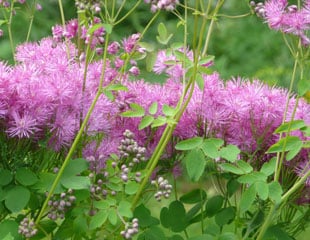
Thalictrum aquilegiifolium
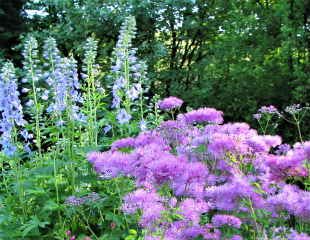
Thalictrum with Delphinium
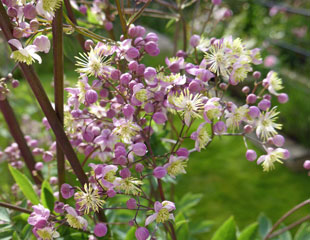
Thalictum delavayi
How to grow Thalictrum
I love Thalictrum. It is a fantastic herbaceous perennial, tall with delicate fluffy flowers which seem to float on the breeze.
The height of Thalictrum depends on the variety some of which reach 1.2 -2.5m. It is one of the best and easiest plants to grow and gives a great height to the borders. Thalictrum, common name Meadow Rue, flowers in the summer and has the additional benefit of long-lasting flowers with attractive seed heads. It is herbaceous, which means it dies back over the autumn, leaving bare earth in the winter, from which fresh new growth appears in the spring.
Thalictrum's preferred growing conditions are soil, which is on the moist side, although well drained. That said, Thalictrum grows reasonably well in most borders in terms of position and soil types. Thalictrum grows best in dappled or partial shade. In sunny spots Thalictrum will do best in soil which is not too dry and in hot dry borders, it may struggle.
Although many varieties of Thalictrum are tall, I have never bothered to stake and despite some gales it has remained (mostly) upright. One advantage of not staking Thalictrum is that the breeze moves the whole plant around. It seems not to mind floating around freely without being staked. If your garden is prone to blustery winds rather than stake Thalictrum, which spoils its lovely ethereal shape, plant around it to give it protection and support, such as with Delphinium or a contrasting shrub.
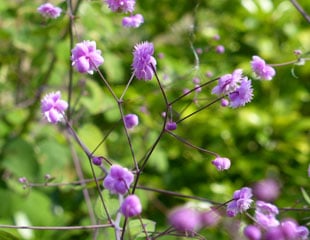
Thalictrum has multiple flower heads which are usually shades of pink/purple and also white, with long-lasting flowers. The image above left show Thalictrum aquilegiifolium which is commonly sold in garden centres. It has the RHS garden merit award and is fully hardy. The other images above are on the right Thalictrum delavayi, also readily available online and in garden centres, and there is also a white variety T. Album. Thalictrum delavayi and aquilegiifolium both grow up to around a meter which makes them ideal for the back of a border. Thalictrum can be cut back after flowering or delayed until the late winter/early spring as the foliage and seed heads remain attractive. I leave the seed heads and usually I am rewarded by seeing small birds perched on them.
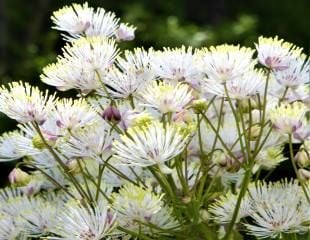
Thalictrum can self seed but not so much as to be invasive and is trouble free. If you need to divide a clump, this is best done early spring or early autumn. Another advantage of growing Thalictrum is that it can be left undisturbed for many years. It does not need regular division, unlike some other perennials. It really is maintenance free.
If there is a little downside to growing Thalictrum its tendency to self seed. The image left is of a lovely white variety known as T. delavayi 'Splendide White ' which is fully hardy and tolerant of dappled shade, preferring soil which is on the damp side.
Thalictrum emerging in Spring
Thalictrum look lovely as the leaves and flowers emerge in the spring. Bright, lime green foliage and buds appear. Thalictrum has a long season of interest. From when it emerges in the spring, following by a long season of flowers, attractive seed heads and then lovely autumn colour.

Thalictrum in Autumn
Thalictrum is one of the herbaceous plants which looks attractive as it dies back.
The seed heads look good for many months after flowering, after which in the autumn the foliage turns a buttery yellow colour with darker stems.
As Thalictrum is herbaceous, once the frosts strike the foliage will collapse, and the plant dies back to bare earth over winter.
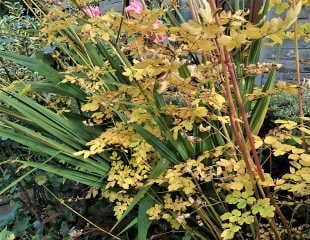
What to Plant with Thalictrum
Thalictrum with Cotinus
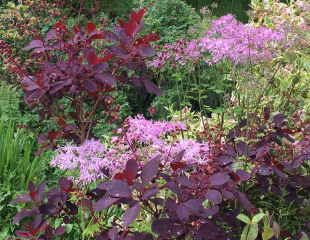
Thalictrum with Delphiniums

Thalictrum streamside
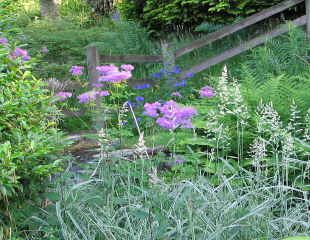
Thalictrum with Clematis

Thalictrum look good with a great variety of plants, including grasses. Thalictrum is a versatile plant, a good planting scheme with a wide range of plants from Clematis to contemporary grasses such as Misacanthus sinensis 'Kleine Silberspinne' or Molinia Caerulea.

I have tagged Thalictrum a green wheelbarrow plant. It genuinely is easy to grow, unfussy about conditions and maintenance free.
If Thalictrum is not the plant for you, there are lots of other great summer flowering plants which combine well with Thalictrum and ideas on summer planting combinations.
